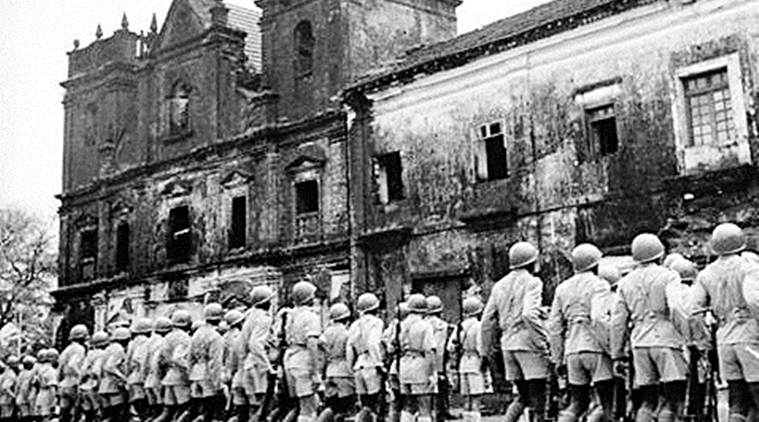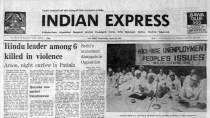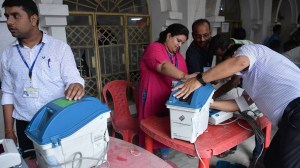- India
- International
4-in-1: The common factor in new UT of Daman & Diu, Dadra & Nagar Haveli
Having made Goa the capital of their eastern empire, the Portuguese gradually turned their attention to Diu, Daman, Dadra and Nagar Haveli — two separate Union Territories which were combined into one with a Bill passed by Parliament last week.
 The Portuguese forces surrendering in Goa. (K C Sethi)
The Portuguese forces surrendering in Goa. (K C Sethi)
By K C SETHI
Vasco Da Gama’s arrival at Calicut, on May 20, 1498, marked the arrival of Portuguese in India and the end of Arab monopoly over trade in the region. It was 12 years later that the Portuguese captured their first territory in India, Goa, defeating Bijapur King Ismail Adil Shah.
Having made Goa the capital of their eastern empire, the Portuguese gradually turned their attention to Diu, Daman, Dadra and Nagar Haveli — two separate Union Territories which were combined into one with a Bill passed by Parliament last week.
The Diu island, located 1,700 km up from Goa along the western coast, was famous for its riches and varied history. The Portuguese failed twice in Diu — first in 1509, in a battle against the combined forces of the Mamluks, Venetians, Ragusians, Zamorin of Calicut, and Sultan of Gujarat Mahmud Begada; and four years later, in a bid to establish an outpost.
In 1535, the new Sultan of Gujarat, Bahadur Shah, afraid of an invasion by Mughal Emperor Humayun, signed an alliance with the Portuguese, allowing them to construct a fort and maintain a garrison at Diu. Even as the alliance unravelled quickly, the Portuguese fought back multiple attempts by the Sultan and his successors to oust them, between 1537 and 1546, before eventually prevailing.

The Portuguese went on to build a huge fort in Diu, strengthening and expanding it over 25 years, and the island emerged as an important port on the flourishing commercial and pilgrimage routes between India and the Middle East. By the mid-1550s, all ships entering and leaving the Gulf of Khambat were required to pay duties to the Portuguese.

The Daman island was acquired by the Portuguese next. They are said to have discovered the island, 700 km away by land from Diu, and on the opposite coast from it, purely by chance. In 1523, a Portuguese ship sailing towards
Hormuz in the Middle East was caught in a huge storm and got stranded off-coast. The commander, Diago de Mello, was enchanted by the grandeur of the port that he saw, and word about it soon reached the king of Portugal. The king ordered that the place be acquired and developed as a commercial port.
The Portuguese went on to battle for 36 years, to eventually capture Daman on February 2, 1559, with Goa Governor Constanino de Braganza launching an attack with a fleet of more than a hundred vessels. De Braganza then ordered a fort built at the harbour, a stone’s throw away from the town market.
Diu and Daman remained in the possession of the Portuguese till way after Independence. On December 19, 1961, Indian soldiers finally ousted them in ‘Operation Vijay’, that involved land, sea and air strikes for 48 hours.
Daman and Diu were then brought under a Union Territory of Goa, Daman, and Diu — despite the distance that separated the three. After Goa became a state in 1987, Daman & Diu became a UT, with Daman as the capital.
Dadra & Nagar Haveli, located 745 km from Diu and 35 km from Daman, too was once occupied by the Portuguese.
The tribal-dominated territory is wedged between Maharashtra and Gujarat, and is known for its natural beauty, with the Western Ghats rising to its east. It is densely populated and home to around 30 tribal groups.
The Portuguese occupied Nagar Haveli on June 10, 1783, on the basis of a friendship treaty that they had executed three years earlier with the Maratha Navy, which offered the territory as compensation for having struck and damaged a Portuguese frigate. Two years later, the Portuguese purchased Dadra from tribal king Tofozon.
Under the Portuguese, Dadra & Nagar Haveli were part of ‘Distrito de Damao (Daman district)’. The two had a single municipality, named ‘Nagar Haveli’. The Portuguese rule in Dadra & Nagar Haveli lasted till 1954, when the territory was occupied by supporters of the Indian Union.
Incidentally, in 1961, as India was preparing to free Goa, Daman and Diu from the Portuguese, IAS officer KG Badlani was designated the Prime Minister of Dadra & Nagar Haveli for one day, so that, as Head of State, he could sign an agreement with Prime Minister Jawaharlal Nehru and formally merge the territories with the Republic of India.
The government hopes that by merging Daman, Diu, Dadra & Nagar Haveli into a single UT, it can provide effective and prompt services to people. Incidentally, even now, the two UTs are under a single administrator, who is headquartered in Daman and visits Silvassa, the capital of Dadra & Nagar Haveli, thrice a week. The two UTs also share departments, though under two different authorities.
Culturally and socially though, the two UTs are far apart, as a majority of the population in Dadra & Nagar Haveli is tribal, while Daman & Diu mostly have fishermen. Geographically, while Daman and Diu are islands, Dadra and Nagar Haveli are located in the plains, bordered by the Western Ghats.
Daman & Diu has a BJP MP while Dadra & Nagar Haveli was won by an Independent in the last election. Daman retains the maximum Portuguese influence among the four areas, including in its cuisine, though multi-storey buildings are fast replacing traditional homes now.
Diu, so far, has resisted this onslaught, with laws forbidding both multi-storey buildings and industries here. Here, Portuguese-built monuments remain in good condition, with the town’s Municipal Council — the first in Asia — and a police station still functioning from a 16th-century building.
Daman, once known as a haven for smugglers, is now famous for its liquor tourism, drawing huge numbers from the neighbouring dry state of Gujarat.
Sethi and wife Sunita Sethi are co-authors of the coffee table book Daman, Diu, Goa, Dadra, Nagar-Haveli & Portuguese Regime (1510-1961)
40 Years Ago
EXPRESS OPINION
Best of Express

More Explained
Apr 19: Latest News
- 01
- 02
- 03
- 04
- 05








































